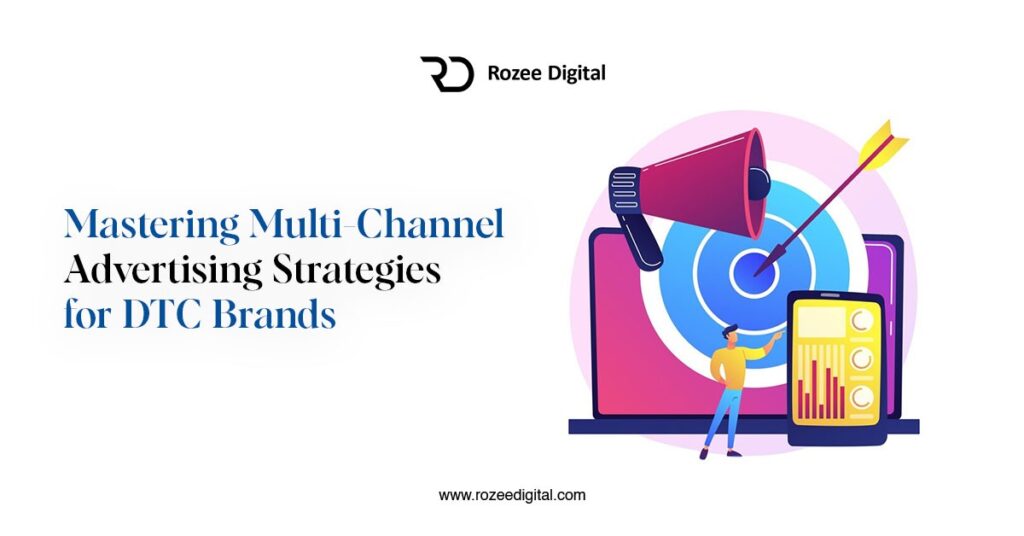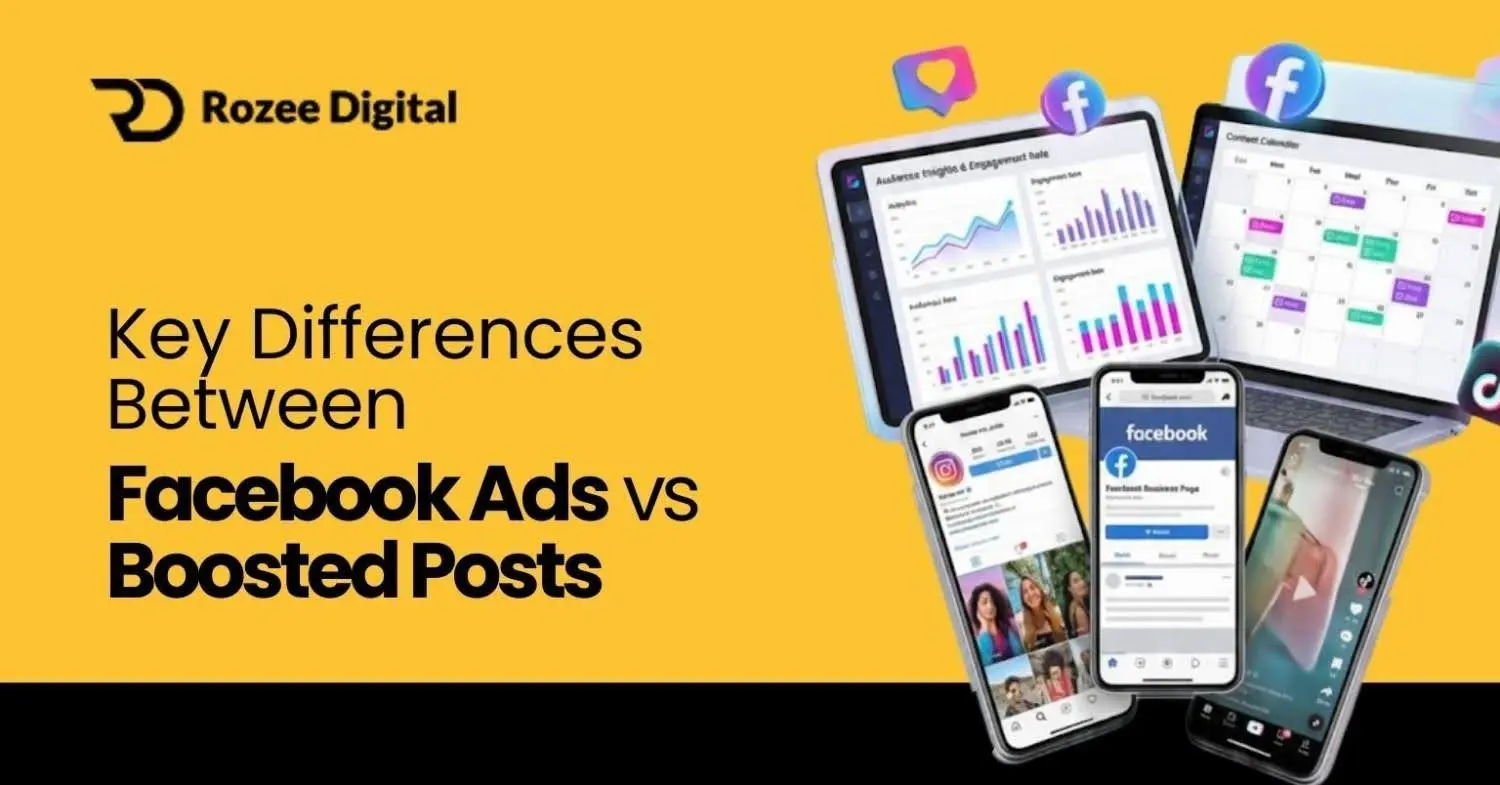These days, customers don’t just stick to one way of reaching out to brands. They might check out a website, follow social media accounts, or even visit a physical store, all during the same shopping experience. But for brands, keeping the message consistent across all these channels can be tough. That’s why many businesses are turning to multichannel digital marketing as their top choice for advertising.
Multi-channel marketing is when DTC businesses use different ways to share and promote their products or services with customers. It combines various methods like emails, websites, social media, and DTC paid ads to reach people. Each channel has its own strengths, like emails for direct communication or social media for sharing news. By using multiple channels, businesses make it easier for customers to buy from them. For instance, they might sell things in a physical store and also online. Let’s delve into some key strategies that can empower DTC brands to thrive in the digital age.
What is Multi-Channel Advertising
Multi-channel advertising is a DTC marketing strategy that involves using multiple platforms or channels to reach and engage with potential customers. Instead of relying on just one channel, such as television or social media, multi-channel advertising utilizes a combination of online and offline channels like email, social media, search engines, display ads, print, television, and radio. So, investing in DTC paid ads on platforms like Facebook, Instagram, and Google can amplify brand visibility and drive traffic to DTC websites or online stores. The goal of Multi-Channel Advertising is to connect with consumers across various touchpoints to increase brand visibility, reach a wider audience, and drive engagement and conversions.
Benefits of Multi-Channel Advertising
Multi-channel advertising offers several benefits for brands looking to reach and engage with their target audience effectively. Here are some of the key advantages:
Increased Reach
By leveraging multiple channels, brands can expand their reach and connect with a broader audience across various platforms and devices. This allows brands to engage with consumers who may frequent different channels or have diverse preferences for consuming content.
Improved Brand Visibility
Utilizing multiple channels ensures that brands maintain a consistent presence in the marketplace, increasing brand visibility and awareness among consumers. This constant exposure helps reinforce brand identity and fosters top-of-mind awareness, making it more likely for consumers to consider the brand when making purchasing decisions.
Enhanced Audience Targeting
Multi-channel digital marketing enables brands to leverage diverse targeting options and reach specific audience segments with precision. By analyzing data from different channels, brands can better understand their audience’s demographics, interests, and behaviors, allowing them to tailor messaging and offers to resonate with different segments effectively.
Greater Engagement Opportunities
Different channels offer unique opportunities for engagement, allowing brands to interact with consumers in various ways. For example, social media platforms enable two-way communication through likes, comments, and shares, while email marketing allows for personalized interactions through targeted messaging. By diversifying their channels, brands can create more meaningful and engaging experiences for their audience.
Improved Customer Experience
A multi-channel approach enables brands to provide a seamless and integrated customer experience across all touchpoints. Consistent messaging, branding, and user experience across channels enhance the overall customer journey, leading to increased satisfaction and loyalty.
Optimized Advertising Performance
By distributing advertising spend across multiple channels, brands can optimize their advertising performance and maximize return on investment (ROI). Monitoring and analyzing the performance of each channel allows brands to allocate resources strategically, focusing on channels that deliver the best results and adjusting DTC marketing strategies for underperforming channels.
Resilience to Channel-Specific Risks
Relying on a single channel for advertising exposes brands to risks such as changes in algorithms, platform policies, or market dynamics. A multi-channel approach diversifies risk by spreading advertising efforts across different platforms, reducing the impact of any single channel’s fluctuations or disruptions.
Adaptability to Consumer Behavior
Consumer behavior is constantly evolving, with trends and preferences shifting over time. A multi-channel approach allows brands to adapt to changing consumer behavior by meeting them where they are most active and receptive. This flexibility ensures that brands remain relevant and responsive to evolving market conditions.
Multi-Channel Advertising Strategies
A multi-channel marketing strategy involves utilizing multiple marketing channels to reach and engage with target audiences across various touchpoints. Rather than relying on a single channel, such as television or print advertising, multi-channel advertising leverages a combination of online and offline channels to create a cohesive and integrated marketing approach.
When crafting a multi-channel marketing strategy for DTC (Direct-to-Consumer) brands, it’s essential to consider the diverse range of channels available to reach and engage with the target audience effectively. Successful multi-channel marketing campaigns leverage various platforms such as email, social media platforms like Facebook and Instagram, websites, search engine marketing (SEM), and display advertising to create a cohesive and integrated brand experience.
The goal of a multi-channel marketing strategy is to maximize brand exposure, increase audience reach, and drive conversions by meeting consumers where they are most likely to engage with the brand. This approach recognizes that consumers interact with brands through multiple channels and devices throughout their customer journey, and seeks to create a seamless and consistent experience across all touchpoints.
Key components of a multi-channel marketing strategy may include:
Online Channels: This includes digital advertising platforms such as social media advertising (e.g., Facebook, Instagram), search engine marketing (e.g., Google Ads), display advertising, email marketing, and content marketing (e.g., blog posts, videos, podcasts).
Offline Channels: This encompasses traditional advertising channels such as television, radio, print, outdoor (e.g., billboards, signage), and direct mail.
Cross-Channel Integration: Multi-channel advertising involves integrating messaging, branding, and user experience across all channels to provide a cohesive brand experience. This ensures that consumers receive consistent messaging regardless of the channel they engage with, reinforcing brand identity and fostering brand loyalty.
Want to elevate your brand with targeted digital marketing? Partner with Rozee Digital, your go-to digital marketing agency for results-driven campaigns. Let’s boost your online presence and drive growth through strategic paid ads. Contact us today to get started!
Key Strategies That Can Empower DTC Brands to Thrive In The Digital Age
Omni-Channel Integration
Omni-channel marketing involves seamlessly integrating all available channels to provide a unified brand experience across multiple touchpoints. For DTC brands, this means maintaining consistency in messaging, branding, and user experience whether a customer interacts with the brand through social media, email, website, or in-store. For instance, implementing targeted DTC marketing examples like personalized email campaigns, engaging content on social media, and strategic SEM campaigns can help DTC brands effectively reach and resonate with their audience across multiple touchpoints. By implementing omni-channel strategies, DTC brands can create a cohesive brand identity and enhance customer loyalty.
Data-Driven Targeting
Utilizing data analytics and audience insights is crucial for DTC brands to optimize their advertising efforts. By leveraging customer data from various sources such as website analytics, CRM systems, and social media platforms, brands can create highly targeted campaigns that resonate with specific audience segments. This includes personalized content, product recommendations, and tailored messaging designed to address the unique needs and preferences of different customer groups.
Social Media Advertising
When crafting a multi-channel marketing strategy for DTC brands, it’s essential to consider the diverse range of channels available to reach and engage with the target audience effectively. Social media platforms like Facebook, Instagram, Twitter, and TikTok offer powerful advertising opportunities for DTC brands to reach their target audience with precision. From sponsored posts and carousel ads to influencer partnerships and user-generated content campaigns, social media advertising enables brands to engage consumers in meaningful ways and drive both brand awareness and conversions. With advanced targeting options and robust analytics, DTC brands can optimize their social media ad spend for maximum ROI.
Search Engine Marketing (SEM)
Search engine marketing, including both search engine optimization (SEO) and pay-per-click (PPC) advertising, is essential for DTC brands to increase visibility and drive traffic to their websites. By optimizing their website content and structure for relevant keywords, brands can improve their organic search rankings and attract qualified leads. Additionally, PPC advertising on platforms like Google Ads allows brands to bid on keywords and display targeted DTC paid ads to users actively searching for their products or services.
Email Marketing Campaigns
Despite the rise of social media and other digital channels, email marketing remains a highly effective tool for DTC brands to nurture customer relationships and drive sales. Through personalized email campaigns, brands can deliver targeted messages, promotions, and product recommendations directly to subscribers’ inboxes. By segmenting their email list based on factors such as purchase history, browsing behavior, and demographic information, DTC brands can tailor their messages to resonate with different audience segments and drive engagement.
Content Marketing Strategy
Content marketing plays a pivotal role in DTC brands’ efforts to build brand authority, educate consumers, and drive organic traffic to their websites. By creating high-quality, relevant content such as blog posts, videos, infographics, and podcasts, brands can establish themselves as thought leaders in their industry and attract and retain a loyal audience. Content marketing also supports other digital marketing initiatives by providing valuable assets to share on social media, include in email campaigns, and optimize for search engines.
Innovative Retargeting Tactics
Retargeting, or remarketing, involves targeting DTC paid ads to users who have previously visited a brand’s website or engaged with its content. DTC brands can leverage retargeting tactics across various channels, including social media, display advertising, and email, to re-engage potential customers and encourage them to complete their purchase or take another desired action. Dynamic retargeting ads that showcase products viewed or abandoned carts can be particularly effective in recapturing the interest of undecided shoppers.
Experimentation and Optimization
Continuous experimentation and optimization are essential components of any successful multi-channel advertising strategy for DTC brands. By testing different ad formats, targeting parameters, messaging variations, and creative elements, brands can identify what resonates most with their audience and allocate their resources accordingly. Additionally, monitoring key performance indicators (KPIs) such as click-through rates, conversion rates, and return on ad spend (ROAS) enables brands to refine their multi-channel marketing campaigns in real-time and maximize their advertising effectiveness.
How to launch an effective multi-channel marketing strategy:
Develop Clear Buyer Personas
Begin by comprehending your ideal customers. Create detailed profiles outlining their demographics, preferences, and behaviors. This insight will steer your decisions regarding channel selection and messaging tone.
Select Channels Thoughtfully
Rather than spreading thin across all platforms, prioritize those that best align with your target audience and business objectives. Consider audience demographics and platform effectiveness. Start with these and gradually expand as you observe positive outcomes.
Maintain Consistent Messaging
Ensure uniformity across all channels. Despite different team members managing various platforms, uphold a cohesive brand experience. Everyone should grasp the target persona and convey consistent messaging that resonates with the audience.
Customize Content for Each Platform
While preserving consistency, tailor your content to suit the unique characteristics of each platform. Visual platforms like Instagram may necessitate different content types compared to text-centric platforms like LinkedIn. Customizing content maximizes engagement and effectiveness.
Seamlessly Integrate Channels
Avoid operating channels in isolation. They should seamlessly collaborate to deliver a unified brand experience. Implement an integration strategy facilitating easy communication and data sharing between platforms, ensuring a smooth customer journey.
Utilize Marketing Automation
Harness marketing automation tools to streamline your multi-channel endeavors. These tools, coupled with customer relationship management (CRM) systems, enable personalized communication based on individual lead behavior and interactions.
Prioritize your Website
Your website acts as a central hub for all marketing activities. Ensure it’s responsive and user-friendly across all devices. A responsive website guarantees consistent access to your content, irrespective of the audience’s device.
Effectively Measure Attribution
Monitor and assess the impact of each channel on your marketing initiatives. Utilize closed-loop analytics and attribution models to discern which channels drive conversions and influence others. This data informs future strategies and optimizations.
Embrace Retargeting
Retargeting is a potent tool to re-engage bounced website visitors. Incorporate it into your multi-channel approach to augment website traffic and conversions. By maintaining a presence across multiple platforms, you amplify your retargeting endeavors.
Wrapping up
In conclusion, mastering multi-channel advertising strategies is imperative for DTC brands seeking to thrive in today’s competitive digital landscape. By integrating omni-channel approaches, leveraging data-driven targeting, and utilizing a diverse mix of channels and tactics, DTC brands can effectively engage their target audience, drive brand awareness, and ultimately increase sales and customer loyalty. With a focus on innovation, experimentation, and optimization, DTC brands can stay ahead of the curve and achieve sustainable growth in the dynamic world of e-commerce.
(FAQs) About Multi-Channel Marketing Strategy
What is multi-channel marketing?
Multi-channel marketing is a strategy that involves using multiple distribution and promotional channels to reach and engage with customers. It combines various methods such as email, social media, websites, ads, and physical stores to communicate the value of a product or service.
Why is multi-channel marketing important?
Multi-channel marketing allows businesses to meet customers where they are and provide a seamless experience across different touchpoints. It increases brand visibility, reach, and engagement, ultimately driving conversions and revenue.
What are some examples of marketing channels used in multi-channel marketing?
Examples of marketing channels include email, direct mail, websites, social media platforms (like Facebook, Instagram, Twitter), display advertising, search engine marketing, mobile apps, and physical retail locations.
How do businesses choose which channels to include in their multi-channel marketing strategy?
Businesses should consider their target audience’s preferences, behaviors, and demographics when selecting channels. They may also analyze the effectiveness and ROI of different channels and prioritize those that are most likely to reach and engage their audience effectively.
How can businesses ensure consistency across different marketing channels?
Consistency is key to successful multi-channel marketing. Businesses should maintain a cohesive brand identity, messaging, and visual style across all channels. They can also use integrated marketing tools and platforms to streamline communication and ensure a seamless experience for customers.
How can businesses measure the effectiveness of their multi-channel marketing efforts?
Businesses can track various metrics such as website traffic, social media engagement, email open and click-through rates, conversion rates, and overall sales and revenue. They can use analytics tools and attribution models to assess the impact of each channel on their marketing objectives.
What are some common challenges of multi-channel marketing?
Challenges of multi-channel marketing include maintaining consistency across channels, managing data and integration complexities, allocating resources effectively, and keeping up with evolving consumer preferences and technologies. However, these challenges can be overcome with proper planning, execution, and optimization.





